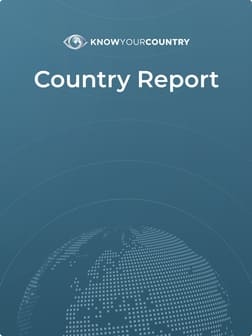
India Country Summary
Sanctions
No
FATF AML Deficient List
No
Terrorism
Corruption
US State ML Assessment
Criminal Markets (GI Index)
EU Tax Blacklist
Offshore Finance Center
Background Information
Anti Money Laundering
FATF Status
India is not currently on the FATF List of Countries that have been identified as having strategic AML deficiencies.
Compliance with FATF Recommendations
The last Mutual Evaluation Report relating to the implementation of anti-money laundering and counter-terrorist financing standards in India was undertaken by the Financial Action Task Force (FATF) in 2010. According to that Evaluation, India was deemed Compliant for 4 and Largely Compliant for 25 of the FATF 40 + 9 Recommendations. It was Partially Compliant or Non-Compliant for 5 out of the 6 Core Recommendations.
Extract from 2014 Asia Pacific Group on Money Laundering Yearly Typologies Report:
The investigation of money laundering cases under investigation where proceeds of crime have been attached under AML provisions, it is noticed that proceeds of crime are mostly invested in immovable properties, followed by jewellery, vehicles etc.
US Department of State Money Laundering assessment (INCSR)
India is categorised by the US State Department as a Country/Jurisdiction of Primary Concern in respect of Money Laundering and Financial Crimes.
Overview
Indian Prime Minister Modi has prioritized curtailing illicit financial activity as part of his administration’s plans to formalize and digitize India’s financial system to reduce corruption and increase the tax base. Nonetheless, India faces various money laundering vulnerabilities such as informal financing networks that largely serve rural citizens; complex onshore and offshore corporate structures; and enforcement capacity constraints.
Sanctions
India is not currently subject to any International Sanctions however the UK government has had a stated policy on exports to nuclear and nuclear-related end users in India and Pakistan since March 2002.
Bribery & Corruption
Rating (100-Good / 0-Bad)
Transparency International Corruption Index 39
World Governance Indicator – Control of Corruption 44
Companies operating or planning to invest in India face high corruption risks. Despite that the government has stepped up its efforts to counter corruption, red tape and bribery continue to be widespread. Corruption is especially prevalent in the judiciary, police, public services and public procurement sectors. Due to varying levels of corruption and quality of government operations across India, local investment conditions vary between and within states. The Prevention of Corruption Act is the principal legal framework that focuses on corruption in the public sector. Both active and passive bribery are covered by legislation, and public officials are only allowed to accept gifts of nominal value. Private sector corruption is addressed by the Companies Act. Due to low levels of enforcement and monitoring, integrity in all state bodies is lacking, and corrupt practices such as facilitation payments and bribes persist. For further information - GAN Integrity Business Anti-Corruption Portal
Economy
As the fastest growing large economy in the world and with a population of around 1.4 billion, India’s GDP is currently $3.2 trillion – making it the world’s fifth largest economy. While India’s economic growth is expected to slow to six percent this year, most economists predict growth will remain at that level for the next two decades due to shifting global supply chains, favorable demographics, and rapid industrialization positioning India to potentially become one of the new “factories of the world.” India is expected to become the world’s third largest economy, surpassing Japan and Germany, within the next decade or perhaps even earlier. Prime Minister Modi has set a goal of India becoming a developed country by 2047, the 100th anniversary of Indian independence. While many experts are skeptical that this is possible, virtually all agree it will make substantial progress towards the goal. Whether India realizes this potential will depend primarily on sound macroeconomic and regulatory policy choices, empowering its women, and upskilling its talent.
India instituted structural economic reforms in recent years that will improve the business environment, including for U.S. exporters and investors. These reforms include liberalizing foreign investment restrictions, modernizing bankruptcy and labor laws, ending retroactive taxation, and replacing a patchwork of state border taxes with a national Goods and Services Tax. However, continued protectionist measures restrict expansion in bilateral trade and make it more challenging for Indian producers to join global supply chains. Protectionist measures include the highest tariffs of any major economy, increased encouragement of manufacturing localization to promote “self-reliance,” and the use of India-specific standards and regulations that effectively exclude foreign goods and services.
Achieving India’s macroeconomic targets will require consistent, affordable energy. Despite significant advances in solar energy capacity, India still relies on coal for 70 percent of its power generation. Global energy price volatility resulting from the Russian war on Ukraine has driven the Indian government to prioritize energy security in its decision-making, since energy supply is key to maintaining the momentum of India’s fast-growing economy. India imports over 85 percent of its oil, and it is highly vulnerable to changes in global energy prices. India has declined to join the international price cap mechanism on Russian oil, arguing the need to secure sufficient energy supplies to prevent shortages and maintain current retail prices of refined petroleum products, though the price it pays nonetheless remains below the cap. Capitalizing on market discounts driven by lower demand for Russian crude, imports of oil from Russia increased dramatically from less than two percent of India’s total imports to over 20 percent over the course of 2022, introducing significant questions about growing dependency on unreliable and politically motivated energy suppliers.
Prime Minister Modi began his ninth year in office with strong political standing. Public opinion polling consistently shows Modi’s approval rating above 60 percent. There are indications that Modi will likely win a third term in India’s 2024 general election. Domestically, Modi is focused on the need to boost India’s economy following COVID-19 disruptions. Job growth is a key focus, as more than a million new people enter the job market each month. Many economists warn excessive focus on technology industry driven growth could potentially lead to “jobless growth,” where the number of new jobs created are not enough to meet the surge in the labor force, resulting in under-utilization of India’s favorable demographic dividend. Trade agreements are one way for Modi to add jobs and increase economic opportunity. Modi is also trying to demonstrate India’s growing global economic leadership, including through hosting the G20 and several ambitious measures Modi announced at COP26 and reiterated at COP27, including India’s plans to reach net-zero emissions by 2070 and cut its carbon-dioxide emissions by one billion tons by 2030. India has made significant progress in reducing emissions intensity and increasing renewable energy power generation capacity, well ahead of the 2030 deadline. However, India will require significant financial/technological support to reach Modi’s aggressive target to install 500 gigawatts of non-fossil fuel power by 2030.
Country Links
Financial Intelligence Unit-India (FIU-IND )
Securities and Exchange Board of India (SEBI)
Insurance Regulatory and Development Authority of India (IRDAI)

Buy Full India Report
$25 one time payment
- Risk Analysis
- Corruption
- Economy
- Sanctions
- Narcotics
- Executive Summaries
- Investment Climates
- FATF Status
- Compliance
- Key Findings

Unlimited Reports
$40 Monthly
